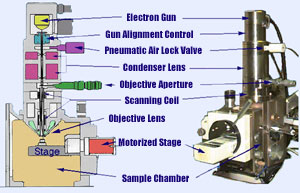|
What is Electron Microscopy? Electron Microscopy involves the study of different specimens by using an electron microscope. Through the use of an electron microscope we can see things that we would not normally be able to see with our eyes. So what makes an electron microscope different from the microscopes you use in science class? An electron microscope uses super small particles called electrons to help us magnify what we are looking at. A regular microscope that you can find in your science class room uses light to magnify specimens. What's good about using electrons instead of light to view specimens is that we can magnify an object up to 200,000 times its normal size. Imagine being able to look at a flea as if it were bigger than you! Unlike your regular microscopes in school, we cannot see things in color using an electron microscope. Also, you can only place inanimate objects in an electron microscope. If you wanted to look at a bug in the electron microscope, it must be dead. Before we can look at a bug (or anything) in an electron microscope, it must first be prepared. The preparation process is three steps: 1.
The specimen must be dehydrated (all water must be removed)
The result is what you see on our cool magnified images page. home ::: what is electron microscopy? ::: see the scopes ::: research ::: cool magnified images ::: take a guess ::: directions ::: contact us |


